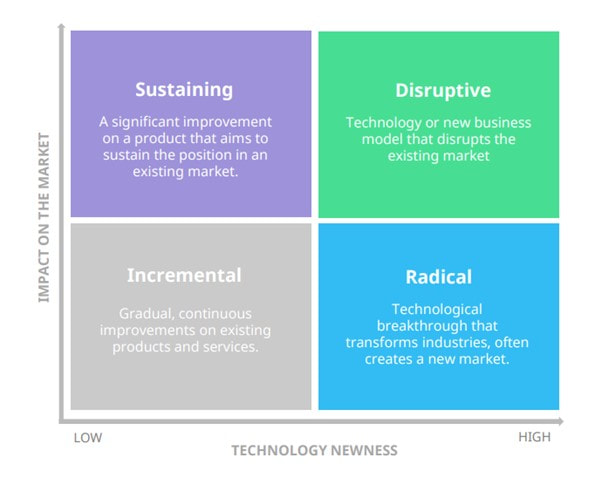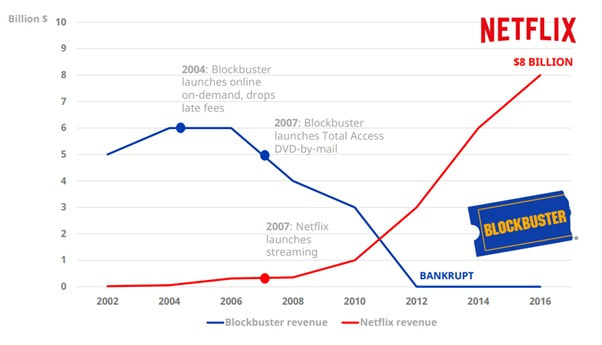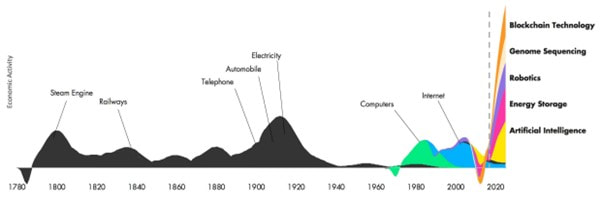From technological to marketing and social innovations, businesses can leverage various types of innovations to improve their operations, differentiate themselves from their competitors, and meet the evolving needs of their customers. In this article, we will explore the different types of innovations and how they can benefit businesses in different ways. A Guide to Categorizing Types of InnovationInnovation can be classified as a new product, service, or business model that uses either new or existing technology in a new or existing market. It is worth noting that most innovations belong to multiple categories, and the categories often overlap. Therefore, the categorization is intended to provide a framework for analyzing and understanding innovation.
Innovation MatrixThe Innovation Matrix is a tool that categorizes innovation based on two dimensions: the impact it has on the market and the technology it uses. The four categories of innovation in the Innovation Matrix are as follows:
Innovation Matrix Incremental InnovationInnovation is often a continuous and gradual process of improving existing products, services, or concepts in an existing market. Incremental innovation involves making slight improvements to the previous version of a product or service, without drastically changing its core functionality. This can include making products smaller, larger, more attractive, or easier to use, while services can be made more convenient, fast, and efficient for users. Incremental innovation is driven by customer needs and feedback, and can attract higher-paying customers. Some of the key characteristics of incremental innovation include:
Disruptive InnovationDisruptive innovation, on the other hand, involves the creation of a new value network by entering an existing market or creating a completely new market. It often creates a new market niche and uses new technology or business models. Disruptive innovation involves high risks and initially yields low profits, but if successful, can make traditional business methods uncompetitive. Disruptive innovation does not happen abruptly but rather requires gradual change and a lot of work before reaching the mainstream, where it can have a significant impact on the market. How Disruption Happens Disruptive innovations often have lower performance when measured by traditional value metrics at first, but have other aspects that are valued by a small segment of the market. These types of innovations can turn non-customers into customers but may not appeal to the needs and preferences of mainstream customers yet. Challenges of Disruptive Innovation Established organizations often struggle to adapt to disruptive innovations. They are typically rational when making decisions related to their existing business and fail to adjust to new competition because they are too focused on optimizing their existing offerings or business models that have proven to be successful in the market so far. Once mainstream adoption of disruptive innovation occurs, it may be too late for incumbents to catch up, despite the resources at their disposal. Netflix vs. Blockbuster Netflix is a classic example of a disruptive innovation that uses new technology and a new business model in an existing market, eventually disrupting Blockbuster. Netflix v Blockbuster Sustaining Innovation Sustaining innovation refers to the gradual improvement of a product or service, with each iteration making the product slightly better and reducing defects. This type of innovation targets high-end customers who demand better performance and are willing to pay more for an improved version of the product. Alternatively, the improved product may be cheaper, leading to higher volumes and profits. The iPhone is an example of a sustaining innovation, where newer versions of the phone appeal to the same customer segments and sustain the existing business model in the premium segment of the market. The characteristics of sustaining innovation include a focus on profitable segments, sustaining or improving market position, improving and growing existing value networks, incremental changes, and the risk of being disrupted. Radical InnovationRadical innovation is a rare form of innovation that utilizes revolutionary technology to solve global problems and address needs in completely new ways. This type of innovation can even provide solutions to needs and problems that people didn't know they had, transforming the market or the entire economy. Radical innovation faces significant resistance initially because it is so different from what people are used to. These innovations require a significant amount of time and technological development before they can be adopted by the mainstream. Characteristics of radical innovation include high uncertainty, exploring radically new technology, unprecedented product features, requiring a lot of time and resources, and creating dramatic change that transforms industries. The Future of InnovationAlthough radical innovations are rare, there has been an increasing number of them in recent times. Currently, a new wave of even bigger radical innovations is on the horizon. With the continuous advancement in technology, there is an ever-increasing potential for radical innovation in various industries. Innovators should, therefore, be prepared to embrace these changes to stay relevant and competitive. The future of innovation is bright, and we can expect to see more radical innovations that will transform the world we live in. The Future of Innovation Other Types of InnovationIncremental, disruptive, sustaining, and radical innovations are important concepts to describe the technology and impact of innovation. However, innovation is not limited to these categories. A more pragmatic and holistic approach is required to achieve concrete and actionable results. This section will introduce other types of innovation that can unlock new value in different parts of your business. Doblin’s Ten Types of Innovation Doblin’s Ten Types of Innovation framework is a useful tool for developing viable innovations across all levels of an organization. It is a diagnostic tool that can assess how innovation can be approached internally and which aspects can be improved upon beyond just technological innovation. The framework divides the different types of innovation into three main categories: configuration, offering, and experience, which correspond to business model, product, and marketing in layman terms. It can be used to revisit existing strategies and identify areas for improvement. In addition to Doblin’s framework, there are other types of innovation that can be useful for improving different areas of your business:
By understanding and utilizing these different types of innovation, you can identify new opportunities to create value and drive growth in your business. Doblin’s Ten Types of Innovation The types on the left side of the framework are the most internally focused and distant from customers. As you move toward the right side, the types become increasingly apparent and obvious to end users. Tips for Using the Framework Effectively To effectively use the ten types framework for innovation, consider the following tips:
Product InnovationProduct innovation is a common form of innovation that involves improving the performance characteristics and attributes of a product. It can also involve using components that differ from previously manufactured products. Product innovations can be built using new technologies or by combining existing ones in a new way, though they do not necessarily have to involve technology at all. Product innovation can improve quality and product reliability, giving a competitive edge or helping to sustain market position, while also reducing processing and manufacturing costs. Focus on Product Innovation when:
Service InnovationService innovation involves the creation of a new or significantly improved service concept, product, or process in a new or existing market. It can be a new customer interaction or distribution channel, a system that improves delivery processes, or new solutions in the customer interface. Differentiating a business through service innovation helps respond better to customer needs and expectations, creating more value and generating new revenue streams. A big part of a successful business is the ability to make your customers lives easier and the better you’re able to meet the needs and expectations of the ones you serve, the brighter your future looks like. Service innovation is a great way to:
UberEATS Uber is an example of a company that has used service innovation to create further growth outside of its core business. UberEATS has used Uber's strengths and unique capabilities to enter adjacent markets, such as restaurant and grocery home delivery businesses. Uber’s unique capabilities enable rapid market entry:
Process InnovationProcess innovation refers to implementing a new or significantly improved production or delivery method, using new technologies or improved methods to save time, money, or better serve customers. It may also involve support function processes in HR or finance. Robotic process automation (RPA), for example, is a type of process innovation that uses software with artificial intelligence and machine learning capabilities to handle high-volume, repeatable tasks that previously required humans. Process Innovation Technology InnovationTechnological innovation is a critical success factor for increased market competitiveness, involving new or improved technology. Incremental innovations improve the existing technology to meet the needs of customers in the existing market, whereas disruptive innovations are game-changers that create a new market. Radical innovations provide solutions that transform the industry, whereas sustaining innovations make gradual improvements to maintain the market position. Technological innovations can be incremental, disruptive, radical or sustaining as follows:
Business Model Innovation Business model innovation involves a fundamental change in how a company delivers or captures value from the market. It includes strategy, resources, capabilities, channels, and values, and often happens through new pricing mechanisms, revenue streams, or distribution channels.
Business model innovation is a fundamental change in how a company delivers value to its customers or captures it from the market. In practice, it often happens through the development of new pricing mechanisms, revenue streams or distribution channels but isn’t limited to them. Signs that indicate that your business is at risk of being disrupted:
iTunes v Spotify Purchasing music, for example, has transformed twice in the past couple of decades. iTunes is an interesting example of disaggregation business model – a strategy that breaks down or separates something into constituent parts or elements. Before iTunes started to sell single tracks, you either had to buy the entire album to hear your favorite song or sit by the radio at the right time to be able to record it. Later, Spotify took the digital music business to a completely different direction with its freemium streaming model by cutting out the middleman and dealing with customers directly online to which Apple now has had to respond with its own Apple Music service. Marketing InnovationMarketing innovation refers to an innovation that brings significant changes to the traditional marketing mix of an industry. Its main objective is to create new markets or increase market share in existing ones. In order for an innovation to be successful, it is essential that people are able to find it and benefit from it. Hence, the ability to connect with customers is crucial and continuous improvement of customer relationships and engagement is necessary. As technology and customer preferences continue to evolve, new marketing innovations are required to promote both new and existing products and services. Innovative marketing practices can help to enhance customer relationships and exceed their expectations. L’Oréal This cosmetics company is a prime example of how technology can be integrated into marketing innovation. The company developed the Makeup Genius App to engage a wider customer group and improve their interaction with the brand. Such innovative technologies not only enhance customer experience but also provide an opportunity to improve the online shopping experience by suggesting products that match the customer's personal preferences. It is important to note that marketing innovations do not necessarily always require new technology to be successful. Architectural InnovationArchitectural innovation, coined by Rebecca Henderson and Kim Clark in 1990, involves the reconfiguration of existing product technologies. The fundamental aspect of architectural innovation is that it changes the relationship between the core components of the product, while the components themselves remain unchanged. This type of innovation deals with the overall design, system, or the interaction of components. One classic example of architectural innovation is the Sony Walkman, which utilized existing components that were previously used in other products. Modular InnovationModular innovation, also known as component innovation, is the opposite of architectural innovation. In modular innovations, one or more components of a product are altered while the overall design remains the same. For instance, a clockwork radio that generates its own electricity and operates for extended periods of time uses the architecture of an established radio but has a unique impact because it can be used in areas with power shortages. Social InnovationSocial innovations are new practices or technological inventions aimed at satisfying social needs better than existing solutions. Public or commercial entities may provide or finance such innovative solutions. While improvement isn't always the result of innovation, some of the critical social outcomes of social innovation are economic growth, enhanced well-being, improved communication, increased educational access, and environmental sustainability from society's perspective. Sustainability and environmental problems such as climate change are challenges that necessitate a lot of effort and innovative solutions now and in the future. Often, policies or other methods are insufficient to effect change, at least not quickly enough. As a result, new, responsible innovative technologies are critical to the long-term survival of our society and nature. Therefore, new green technology solutions, such as eco-friendly vehicles and clean water solutions, will undoubtedly provide numerous benefits in the future. Overall, understanding the different types of innovation and leveraging them effectively can help businesses create new opportunities, generate more revenue, and gain a competitive edge. By considering each type and exploring new ways to configure them, businesses can make significant strides towards innovation and growth. SummaryInnovation is a vital aspect of progress and development, and it has played a significant role in shaping human society throughout history. From simple inventions like the wheel to more complex innovations like the internet, human beings have always strived to improve their lives through innovation. Innovation is not just about creating new products or services; it is also about finding new ways to solve problems, improving processes, and creating value for customers. Today, innovation continues to be a key driver of economic growth, and businesses that prioritize innovation are more likely to succeed and thrive in a rapidly changing marketplace. However, innovation is not always easy, and it requires creativity, risk-taking, and a willingness to experiment and learn from failure. Companies that foster a culture of innovation and invest in research and development are more likely to stay ahead of the curve and stay competitive in the long run. In conclusion, innovation is a crucial aspect of human progress, and it will continue to shape our future in countless ways. Whether it's improving healthcare, advancing technology, or creating new forms of entertainment, innovation has the power to transform our world and create new opportunities for growth and prosperity. By embracing innovation and investing in research and development, individuals and organizations can unlock their full potential and make a positive impact on the world around them.
0 Comments
Leave a Reply. |
AuthorTim Hardwick is a Strategy & Transformation Consultant specialising in Technology Strategy & Enterprise Architecture Archives
March 2025
Categories
All
|







